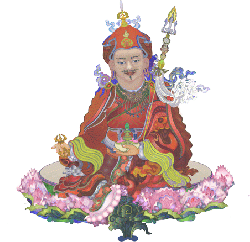Mahayoga
Mahayoga is called the “great yoga” because it brings realization of non-duality. Its gateway consists of four main empowerments: the vase, the secret, the wisdom, and the symbolic (or word) empowerment. These purify the defilements of the body, speech and mind, as well as their subtle obscurations, and enable the practitioner to realize the Four Kayas, respectively.
View: Awareness, free from conceptual limitations, is regarded as absolute truth and inherently endowed with all enlightened qualities. All phenomena – the outer universe, the various psychophysical elements of the body as well as thoughts – arise as a mandala which stands for relative truth. The two truths – emptiness and phenomena – are inseparable, like gold and its color.
Meditation: Mahayoga emphasizes the development stage which focuses on the process of visualization. The practitioner sees herself as a deity who is the very manifestation of her own wisdom nature. The outer world is seen as a buddhafield and the beings therein as male and female deities. These methods help the practitioner to recognize the primordial, unchanging purity of phenomena that is the true condition of all things.
The practitioner also engages in the completion stage that is related to the subtle channels (nadi), energy (prana), and essence (bindu). Formless meditation involves merging the mind with the profound, absolute nature.
Action: With confidence cultivated through skillful means such as devotion and pure perception, without rejection or attachment the practitioner uses samsaric experience as a catalyst to foster the practice.
Fruit: Realization is attained within this lifetime or in the ensuing bardo, the transitional state between death and rebirth.
